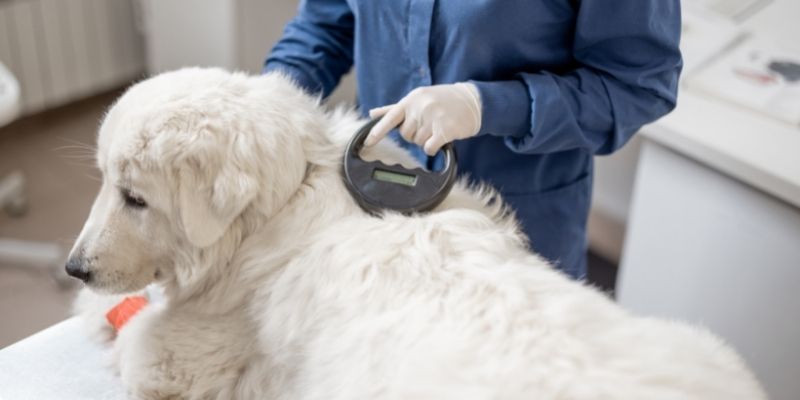One of the significant concerns that any dog parent would have is the fear of their furry buddy getting lost. The thought of your canine companion going missing can be devastating. Given that it’s quite a common risk for dogs to lose their way back home and consequently end up in a shelter, it’s very important to take measures to protect their identity and safety.
So, as a dog owner, you may have considered giving your furry companion a microchip. But, do microchips in dogs expire? This is a common concern that dog parents have. So, if you’re wondering whether microchips do expire in dogs, read on!
Do you have a specific question about the dogs’ microchips expiration? Then use the table of contents below to jump to the most relevant section. And you can always go back by clicking on the black arrow in the right bottom corner of the page. Also, please note that some of the links in this article may be affiliate links. For more details, check the Disclosure section at the bottom of the page.
Here's what we'll cover:
What is a microchip for dogs?
You must understand the meaning, purpose, and functionality of microchips in dogs before asking whether or not microchips in dogs expire?
A microchip implant in dogs is basically a radio-frequency identification transponder. A microchip is approximately the size of a rice grain. A microchip implant in dogs carries an identification number unique to your dog. It comes preloaded in a sterile application device.
A microchip is injected into your dog’s body under loose skin, usually between their shoulder blades. It’s around 12mm in length. Microchips are typically injected by veterinary professionals.
How does a dog microchip implant work?
Before you decide whether you’d like your dog to get a microchip and ask whether microchips in dogs expire, let’s understand how it really works.
As already mentioned, a microchip implant is an RFID (radio-frequency identification device). Suppose a dog with a microchip implant does get lost by any chance. In that case, when he/she is taken to a vet or an animal shelter, the dog can be identified with the help of a microchip. How? Well, the veterinarian or personnel in the shelter had to run the RFID scanner across the dog’s body. That’s it.
When the scanner is passed over the dog’s body, it gets adequate power from the RFID. This transmits the unique identification number of the microchip.
Since the microchip is an implant that works on radio-frequency, it doesn’t need any power or batteries. So, there’s no need to charge the microchip. In addition, microchips don’t even have any moving parts, so there’s no risk of wear and tear or replacement.
Debunking myths about microchips
Another critical aspect that must be addressed before deciding whether you’d like your dog to have a microchip implant is the common myths associated with microchip implants. Before asking the question- “do microchips in dogs expire?” let’s debunk the following myths:
Microchip implants and GPS devices work in the same way
No, microchip implants aren’t tracking devices such as GPS. Microchips provide a permanent identification number for your dog. Microchips work on RFID technology, whereas GPS requires a power source. Unlike a GPS device, you can’t rely on a microchip implant to track your dog’s movement or location in real-time.
Injecting a microchip implant can be painful for my dog
You don’t have to worry about your dog feeling any pain while injecting a microchip implant. Licensed veterinarians inject the tiny chip (12mm) chip. The microchip implant procedure doesn’t even require any anesthetic. It’s a very simple procedure that only takes a few seconds to execute.
Although collar tags with your phone number and other vital information are a great safety measure, it isn’t foolproof. In unfortunate kidnapping cases, a dog’s collar is the first thing that is removed. However, there is no way a microchip implant can be removed because it is injected inside your dog’s body. Therefore, it’s best to opt for both to maximize your dog’s safety.
The longevity of a microchip implant
Let’s finally address the question- do microchips in dogs expire? The good news is that since microchips don’t require any power source and batteries and don’t have any moving parts, they don’t need to be replaced! Once it’s been injected, it’s there in your dog’s body for its entire lifespan.
The only thing to remember when it comes to dog microchip implants is that you must use a registered microchip implant and remember to update your registration information in case of any changes.
Thanks for the blog graphics: Canva.com

Thanks for the blog graphics: Canva.com
Doghint.com is a participant of several affiliate programs. The list includes (but not limited to) the following: VigLink, Refersion, ShareASale, and Amazon Services LLC Associates Program, an affiliate advertising program designed to provide a mean for us to earn fees by linking to Amazon.com and affiliated sites. Doghint.com does not intend to provide veterinary advice. All published articles are meant for informational purposes only and not substitute the professional veterinary consultation.


